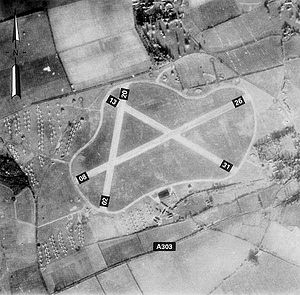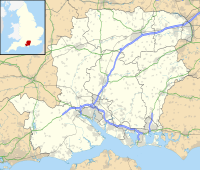RAF Thruxton
| Royal Air Force Station Thruxton USAAF Station AAF-407  | |
|---|---|
| Located Near Thruxton, Hampshire, England | |
 Thruxton Airfield - May 1945. Already large numbers of combat aircraft being stored at the airfield, parked wingtip to wingtip on the grass areas, prior to their being returned to the United States. | |
| Coordinates | 51°12′29″N 001°36′02″W / 51.20806°N 1.60056°W |
| Type | Military airfield |
| Code | TX |
| Site information | |
| Controlled by | Royal Air Force United States Army Air Forces |
| Site history | |
| Built | 1941 |
| In use | 1942-1946 |
| Battles/wars | European Theatre of World War II Air Offensive, Europe July 1942 - May 1945 RAF Thruxton, shown within Hampshire |
| Garrison information | |
| Garrison | RAF Bomber Command Ninth Air Force |
| Occupants | 225, 297 Squadrons 366th Fighter Group |

RAF Station Thruxton (Also known as Thruxton Airport) is a former World War II airfield in Hampshire, England. The airfield is located approximately 5 miles (8.0 km) west of Andover; about 66 miles (106 km) southwest of London
Opened in 1942, it was used by both the Royal Air Force and United States Army Air Force. During the war it was used primarily as a combat fighter airfield. After the war it was closed in 1946.
Today the remains of the airfield are located on private property being used as agricultural fields and also as a glider airfield.
Overview
In the summer of 1940, Thruxton Down, on the eastern fringes of Salisbury Plain, was considered as an emergency landing ground for the regular RAF station at Andover. It was then scheduled for development as a regular airfield for Army Co-operation Command and No. 225 Squadron RAF moved in with Westland Lysanders in August 1941 while construction was still in progress.
The airfield was upgraded to Class A airfield standard with a set of three converging runways each containing a concrete runway for takeoffs and landings, optimally placed at 60 degree angles to each other in a triangular pattern. The main was aligned 08/26 was 4,680 ft long (1,430 m), the secondaries 3,600 ft (1,100 m) at 13/31 and 3,000 ft (910 m) at 02/20. On completion of the improvements there were 29 hardstands, of which 24 were 125-foot-diameter pans (38 m) and six double pans connecting to an enclosing perimeter track, of a standard width of 50 feet (15 m).
The ground support station was constructed largely of Nissen huts of various sizes. The support station was where the group and ground station commanders and squadron headquarters and orderly rooms were located. Also on the ground station were where the mess facilities; chapel; hospital; mission briefing and debriefing; armory and bombsite storage; life support; parachute rigging; supply warehouses; station and airfield security; motor pool and the other ground support functions necessary to support the air operations of the group. These facilities were all connected by a network of single path support roads.
The technical site, connected to the ground station and airfield consisted of a T-2 hangar supplemented by nine Blisters and an aged timber and fabric Bessonneau hangar for aircraft maintenance. In addition various organizational, component and field maintenance shops along with the crew chiefs and other personnel necessary to keep the aircraft airworthy and to quickly repair light and moderate battle damage. Aircraft severely damaged in combat were sent to repair depots for major structural repair. The Ammunition dump was located on the southeast side of the airfield, outside of the perimeter track surrounded by large dirt mounds and concrete storage pens for storing the aerial bombs and the other munitions required by the combat aircraft.
Various domestic accommodation sites were constructed dispersed away from the airfield, but within a mile or so of the technical support site, also using clusters of Maycrete or Nissen huts. The Huts were either connected, set up end-to-end or built singly and made of prefabricated corrugated iron with a door and two small windows at the front and back. They provided accommodation for personnel, including communal and a sick quarters.
RAF Bomber Command use
Thruxton was used as a maintenance and repair facility for No. 225 Squadron's Lysanders. 225 squadron was re-armed during 1942 with Hawker Hurricanes and then North American Mustangs. Following use by several RAF units involved in the Dieppe Raid debacle in August, other Army Co-operation squadrons came and went, mostly equipped with Mustangs. In 1943, No. 225 was displaced as principal resident by No. 297 Squadron RAF with Whitley bombers, and later, Albemarle transports to tow Horsa gliders.
A glider training unit was also present during the winter of 1943-44 but all RAF tactical fighter and airborne support units were moved out in February 1944 to make way for the US Ninth Air Force.
USAAF use
Before Thruxton could be used by Ninth Air Force fighters, it was necessary for US engineers to put down Marsden Matting and concrete reinforcements beside the perimeter track to provide additional aircraft standings. While a good proportion of the personnel could be housed in the hutted accommodation on the dispersed camp, this only catered for 1124 persons so others had to live under canvas tenting.
While under USAAF control, it was known as USAAF Station AAF-407 for security reasons, and by which it was referred to instead of location. It's Station-ID was "TX".
366th Fighter Group
Thruxton was transferred to the USAAF Ninth Air Force on 3 January 1944. On 1 March the 366th Fighter Group was transferred to the airfield from RAF Membury. Operational squadrons of the group were:
- 389th Fighter Squadron (A6)
- 390th Fighter Squadron (B2)
- 391st Fighter Squadron (A8)
The 366th was a group of Ninth Air Force's 71st Fighter Wing, IX Tactical Air Command.
The 366th FG flew Republic P-47 Thunderbolts on ground attack missions and the group entered combat on 14 March with a fighter sweep along the French Normandy coast. Subsequent operations were designed to prepare the way for the invasion of the Continent. On D-Day, the group flew fighter sweeps over Normandy, attacking such targets as motor convoys and gun emplacements.
The group lost 27 P-47s on missions flown from Thruxton. In air fighting, the CO, Colonel Dyke Meyer, shot down two enemy aircraft on the 12 April mission but the most successful was 12 June when 10 enemy aircraft fell to the group's guns. The total of credits of enemy aircraft shot down while flying from Thruxton was 23. The group moved to its Advanced Landing Ground (ALG) at St. Pierre du Mont, France (ALG A-1) on 17 June constructed right behind the coastline near Omaha Beach only six days after the first landings. The last squadron to move to France was the 398th FS, leaving on the 20th. A rear party of USAAF personnel remained at Thruxton until July.
From the continent, the 366th FG frequently attacked such targets as railroads, highways, bridges, motor transports, gun emplacements, supply depots and troops, providing tactical air support in support of U.S. First Army. The group often escorted bombers that hit airfields, factories, and marshalling yards and sometimes flew area patrols and on occasion dropped leaflets.
The group flew its last mission, attacking harbors at Kiel and Flensburg, on 3 May 1945 from its ALG at Münster/Handorf Airdrome (ALG Y-94), Germany. It remained in Germany after the war and, assigned to the United States Air Forces in Europe, becoming part of the occupation force.
The 366th Fighter Group was inactivated at Fritzlar, Germany on 20 August 1946.
Post Invasion use
With the Ninth Air Force move to France, this marked the end of Thruxton as a base for combat flying units. The airfield was again available for use by airborne forces although only training, maintenance and storage units were based there during the months leading up to the end of hostilities.
Thruxton was also used by light communication and transport units, but the main use of the airfield was glider storage of Horsa gliders. The airfield was finally closed and sold in 1946.
Civil use
Upon its release from military use, in 1947 the field was leased by the Wiltshire School of Flying. Over the next few years their training fleet was joined at Thruxton by substantial numbers of light aircraft.
Flight training at the airfield is now provided by Western Air (Thruxton) Ltd at what is now known as Thruxton Airport. The southwest end of the former 02/20 secondary runway is now used as an aircraft parking ramp with the airport facilities also being built on the former runway. The northeast end of the runway still exists, but is largely abandoned, with parts of it also used for aircraft parking. The airport uses part of the former main 08/26 wartime runway for takeoffs/landings. A grass runway was built parallel to the 13/31 secondary runway, the wartime concreted runway being in a deteriorating state and unused.
Thruxton airfield is also the operational base for Hampshire and Isle of Wight Air Ambulance service.
Motorcycle racing started in 1950 with the famous Thruxton 500 motorcycle endurance race, followed by cars in 1952. The runway and perimeter roads formed the original circuit until a new track was laid in 1968 utilizing the former airfield perimeter track At 2.356 miles (3.792 km), the new circuit uses only the perimeter road with the addition of a chicane called Club and a series of three tight corners called Campbell, Cobb and Seagrave. All of the loop and pan dispersal areas have been removed.
There is no flying on race days but the airfield is used for flying during practice and test days on the motor circuit.
See also
References
![]() This article incorporates public domain material from the Air Force Historical Research Agency
This article incorporates public domain material from the Air Force Historical Research Agency
- Freeman, Roger A. (1994) UK Airfields of the Ninth: Then and Now 1994. After the Battle ISBN 0900913800
- Freeman, Roger A. (1996) The Ninth Air Force in Colour: UK and the Continent-World War Two. After the Battle ISBN 1854092723
- Maurer, Maurer (1983). Air Force Combat Units Of World War II. Maxwell AFB, Alabama: Office of Air Force History. ISBN 0892010924.
- Thruxton Airfield at www.controltowers.co.uk http://www.controltowers.co.uk/T-V/Thruxton.htm
- USAAS-USAAC-USAAF-USAF Aircraft Serial Numbers—1908 to Present [1]


